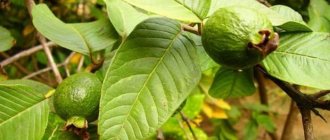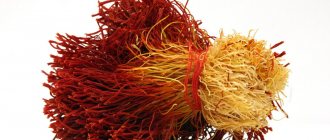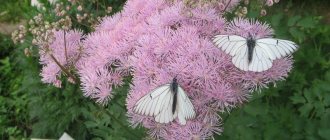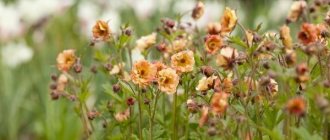Pomegranate is considered one of the healthiest and most delicious fruits in many countries. This plant is cultivated in gardens as a fruit tree that bears a rich harvest of valuable fruits.
Thanks to its large, attractive flowers of red, pink, cream, yellow and white, it is valued as an ornamental crop. Used to create hedges and bonsai.
Today there are several types and varieties of pomegranate, which differ in fruit color, composition and impact on the human body.
There are light and dark types of pomegranate fruit. Light-colored pomegranates taste sweeter than dark ones.
Common pomegranate is a short tree or shrub, reaching up to 5 m in height. The native land of the plant is North Africa. The shrub is widespread in the Caucasus, Dagestan, the Himalayas, Iran and Asia Minor. It has thin, smooth branches of a yellow-brown hue. The trunk is uneven, covered with small spines.

Leaves are wide, rounded, oblong, glossy, opposite, 2-8 cm long, 2-3 cm wide, gathered in bunches. They keep on short petioles.
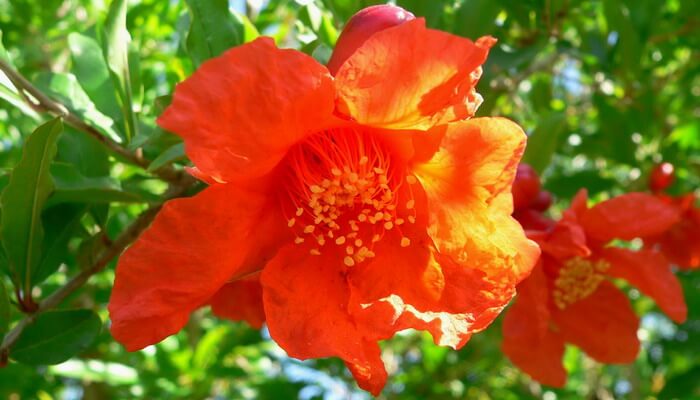

The flowers are bright red, collected in inflorescences of 2-5 pcs. Blooms from May to June.
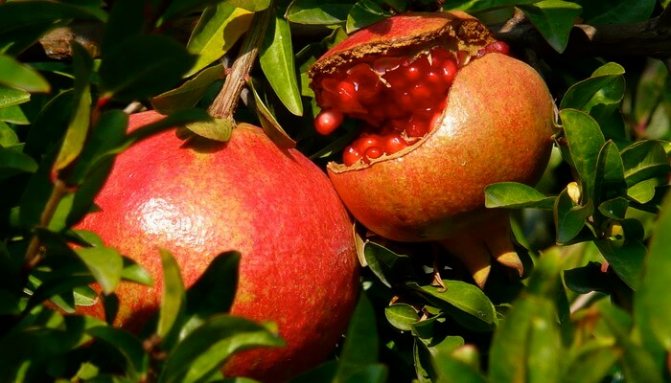

The fruit is round, large, 9-17 cm in diameter, contains numerous seeds surrounded by juicy sweet and sour pulp. Covered with a hard skin from yellow-olive to pink. Thanks to the large, rounded fruits, the common pomegranate received the second name "granular apple". Fruiting in September-October.
How many varieties of pomegranate are there
More than 500 cultivated varieties are known. Thanks to the efforts of breeders, there are more and more of them. The main task is to create a plant that will be resistant to diseases and weather changes.
In the Nikitsky Botanical Garden, which is located in the Crimea, near the city of Yalta, there is something to see. There are 340 varieties of pomegranate there. Among them are types of domestic selection, as well as cultures of foreign origin that do not grow in temperate climates.
There are even more varieties of pomegranate in Turkmenistan, or rather in the Kara-Kala reserve. This is the largest collection in the world. In total, there are 800 species and forms of pomegranate on the territory.
Origin
The pomegranate has been known to mankind for more than four thousand years, the Italians are sure that it was Eve who proposed it to Adam in the Garden of Eden, some languages contain the word apple in the names of this fruit. At all times, people not only enjoyed the luxurious taste of its berries, but also were treated with all parts of the plant, as can be seen by reading the treatises of Avicenna. This culture grows in a subtropical climate, which means that it comes to us from Western Asia, Azerbaijan, Armenia, Georgia, Turkey, Afghanistan.


The fruits can be stored for a long time at a temperature of +2 degrees and a humidity of at least 85%. They ripen from mid-September, and then they are transported to all continents. The closer the path, the more confidence that they are ripe, so you need to choose those fruits that are ripe closest to us. Before buying expensive and such useful fruits, it is advisable to inquire about their origin - there is a difference between the time and conditions of delivery from Turkey or Turkmenistan.
What are the varieties of pomegranate
There are only two types of pomegranate in the pomegranate family - common pomegranate and Socotransky pomegranate.As a result of hybridization, many varieties and species have appeared. They have a different fruit color, composition and effect on the body.
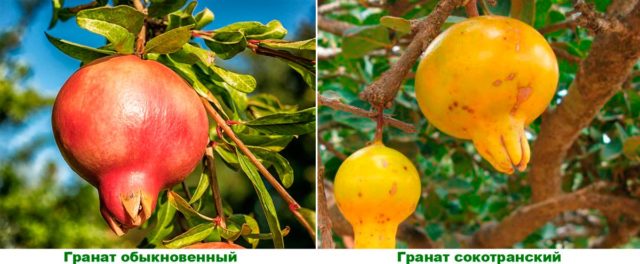

Ordinary pomegranate variety
A long-term tree from a subtropical climate. Life expectancy is 50 years. Productivity from one tree is 60 kg. It grows to a height of 5-6 m. The branches are thin, prickly. The leaves are green, glossy. The fruit resembles an orange in size. Skin color from orange to brownish red. The growing season lasts 6-8 months. Formation and ripening of fruits occurs within 120-150 days.
Pulp and grains contain malic, citric, oxalic acid, vitamin C, sugar, and minerals. The peel contains tannins, vitamins, steroids, carbohydrates.
The wild-growing tree is widespread in the Transcaucasus, Tajikistan, and Uzbekistan.
Sokotransky pomegranate variety
A native of Socotra Island. It is quite rare in the wild. An evergreen tree grows 2.5-4.5 m in height. The shape of the leaves is oblong, rounded. Unlike common pomegranate, it has pink inflorescences, a different structure of the ovary, smaller fruit, low sugar content. Prefers limestone soils. Occurs on rocky plateaus, 250-300 m above sea level. Not cultivated.
In accordance with the variety, pomegranate fruits are distinguished by their appearance. The color of the skin is scarlet, burgundy, sandy yellow, orange. The grains vary in color. Pomegranate varieties are characterized by the intensity of the red color or its absence. There is a pulp of white, light pink, yellow, raspberry or almost black shades. Light varieties of pomegranate have a sweeter taste than dark ones.
Yellow garnet


This fruit looks like an unripe fruit. The unusual color attracts a lot of attention. The taste is sweet, it can be said that there is no acid at all. The grains are pale pink in color. The skin is thin.
A seasoning for meat and fish dishes is prepared from yellow pomegranate. Yellow juice is suitable for making syrups, sauces, sweet drinks.
Attention! When buying a yellow pomegranate, you should carefully examine the skin. It should not have dents, dark spots, damage.
The fruit can be frozen. To do this, the pomegranate is placed in a plastic bag and put into the refrigerator for long-term storage.
Symbol of health and longevity
Nature has generously endowed the pomegranate with healing properties. The ancient Greeks, Egyptians, Byzantines worshiped a wonderful fruit: its images were found in the Egyptian pyramids, embroidery of magnificent Byzantine fabrics, on Greek ornaments.
The pharaohs drank pomegranate juice every day, firmly believing in its healing properties. Prophet Muhammad recognized pomegranate as an amazing gift of nature and urged to take it for food, believing that pomegranate juice can cleanse a person from hatred and envy.
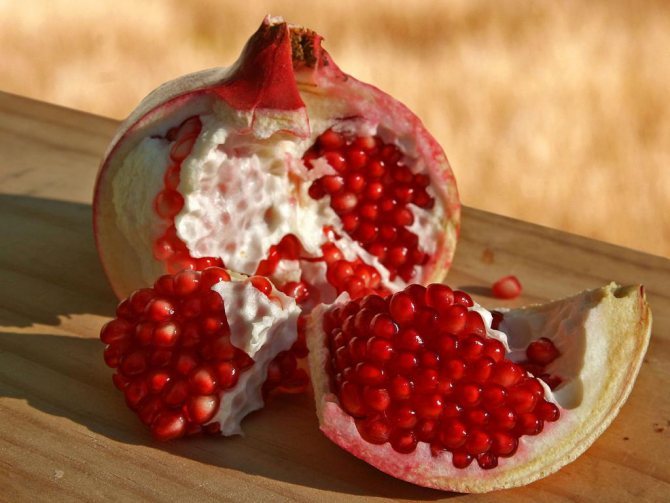

What is the symbol of pomegranate in the myths of Ancient Greece? It follows from them that this fruit is capable of giving a person immortality. For this reason, it was the favorite food of the gods of Olympus. According to one of the myths, the god Hades once visited the human world and met the beautiful girl Persephone, who was the daughter of the goddess of fertility Demeter.
Hades fell in love with her, barely looking at the beauty. He kidnapped the girl, taking her to his underworld. The mother longed for her daughter: the land became barren, the trees died in the gardens, the fields were empty. And then Zeus intervened in this situation, demanding that Hades return Persephone. Hades was forced to obey, but before returning the girl, he gave her pomegranate seeds to taste. Because of their extraordinary taste, Persephone began to return to the kingdom of Hades every winter.
Modern doctors confirm that the pomegranate, as a symbol, fully justifies its meaning. Its use is fully justified in complex therapy for:
- low vision;
- hypertension;
- weakened immunity;
- sore throat;
- normalization of hormonal levels;
- anemia.
Many countries of the world every year supply to the markets not only the fruits themselves, but also products from them, for example, pomegranate juice. The popularity of wonderful fruits is undoubtedly due to their numerous beneficial properties that have a beneficial effect on the body. So, pomegranate contains:
- Sahara;
- tannins;
- a large amount of vitamin C;
- fiber;
- trace elements and minerals.
Pomegranate juice contains:
- anthocyanins;
- fructose and glucose;
- malic, oxalic and citric acids;
- chloride salt;
- tannin.
It is thanks to such a rich composition that doctors strongly recommend drinking it for anemia, and use the peel decoction for burns and various diseases of the gastrointestinal tract.


Popular varieties of pomegranate
All known types and varieties of pomegranate are divided into two groups. The fruits of the first group have a hard and dense bone. They grow in a region with a warm climate. Fruit trees are undemanding to soil and external conditions. The second group is plants with soft bones. These cultures are whimsical and receptive. They grow in a certain area. They dry up if the soil, humidity, air temperature are not suitable.
Gardeners prefer medium to early ripening varieties. Early pomegranates practically do not need shelter for the winter, they quickly take root and grow. Fruiting of such trees occurs 3 years after planting, and by 7 years the yield reaches 10 kg.
Mangulati sweet
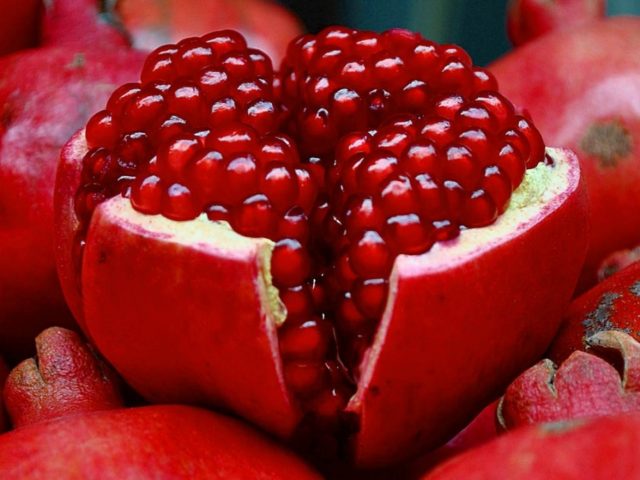

The fruit is native to Israel. Fruits are medium in size. Weight 180-210 g. Under favorable conditions, the plant will stretch up to 5 m in height. The pulp has a pleasant sweet taste with a sour taste, which is more an advantage than a disadvantage. In Israel, the pomegranate tree symbolizes love. Oil is made from its seeds. The substance is actively used in the cosmetic field.
Akdona


The culture that is grown in Uzbekistan and Central Asia. Tall but compact bush. The shape is flattened round. The mass of the pomegranate is 250-600 g. The skin is smooth, shiny, beige in color with a raspberry blush. The grains are elongated, pink in color. Calyx conical with curved teeth. Pomegranate juice turns out to be light pink in color, sweet in taste. Its sugar content is 15%, acid - 0.6%. The fruit ripens in October. The shelf life is 60 days. The yield per bush is on average 20-25 kg.
Achik-anor


A variety of red garnets. It was obtained by scientists from Uzbekistan by selection. Fruit weight on average 450 g. Plant height 4.5 m. Lush, branched bush. The pulp is overly sweet, but due to the inherent acidity, the taste is not sugary. A distinctive feature is the peel of a dark green carmine shade. The skin is dense. In ripe fruits, it is carmine-colored inside.
Baby
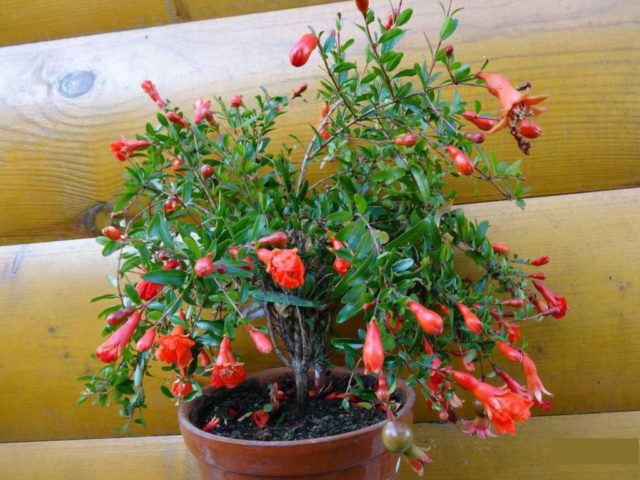

The second name is "Carthaginian apple". The appearance of the variety was noted in the countries of the Mediterranean and Asia. Due to its miniature size, the variety is suitable for home cultivation. Leaves are oblong in shape, collected in groups. The sheet plate is glossy. The branches are covered with small thorns. The fruits are orange or red. More related to decorative varieties. Does not grow higher than 50 cm. The bush, planted in a pot, blooms beautifully and for a long time. However, so that it does not lose its attractiveness, the plant must be regularly pruned. With the arrival of autumn, part of the foliage falls off - this is a natural phenomenon. The pomegranate needs rest for 1-2 months. New leaves will appear in the spring.
Carthage


Homeland - Carthage. The bush is no higher than 1 m in height. Due to the long and abundant flowering, the plant is used as a decoration. Suitable for indoor growing. The foliage is oblong green. Flowers are yellow or white. The fruits are small and not intended for human consumption. Ordinary pomegranate tastes better than the Carthage variety.
Important! To maintain the correct shape and aesthetics, branches should be cut.
Nana
The pomegranate was brought to the European continent from Asia Minor, Iran. The foliage is small, oblong. The height of the shrub is 1 m. It is a reduced copy of a garden bush. The flowers are oblong, sometimes with elongated petals that form the fruit. The second type of inflorescences - the petals are short, they do not have an ovary. The fruits are elongated. The Nana variety tastes sweet and sour. The bush is capable of completely shedding foliage. It all depends on the growing conditions. The plant loves warmth, needs daily watering.
Bedana
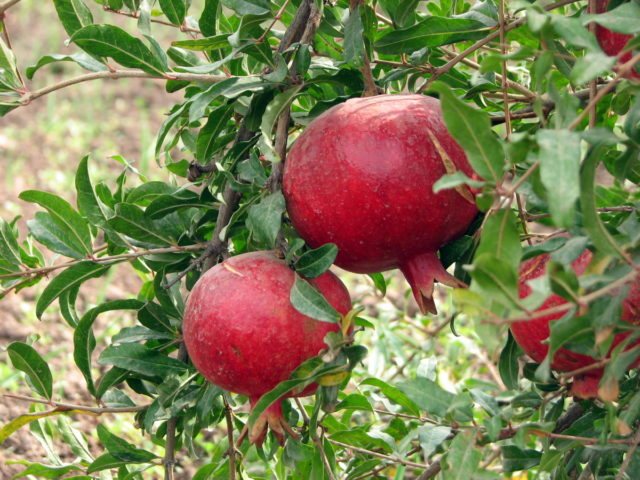

One of the best Indian pomegranates. The growing area stretches from the territory of Iran and up to North India, capturing the Himalayas. The evergreen shrub is large and the fruits are small. It prefers to grow pomegranate in regions with dry, hot summers and cool winters.
Cossack improved
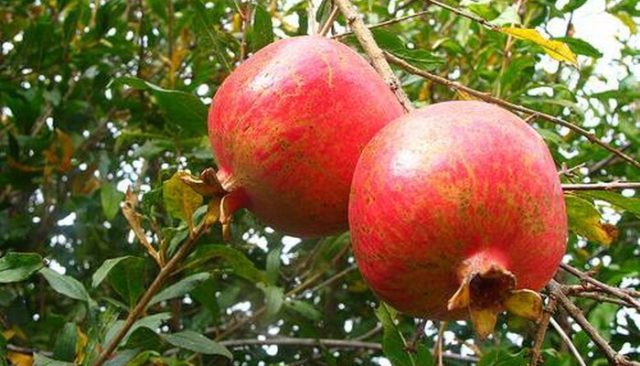

Medium-sized pomegranate tree. The fruits are round in shape. Cream-colored surface with green stripes around the entire circumference. Carmine skin tone is common. The skin is thin, yellow inside. The grains are red and pink, large. The taste is sweet.
Guleisha pink
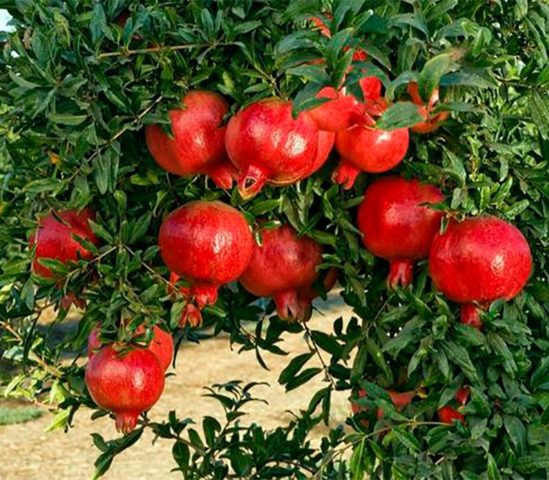

A hybrid variety obtained by breeders of Azerbaijan. Sprawling bush grows up to 3 m in height. The branches are covered with thorns. This variety of pomegranate forms fruits of different sizes. The fruits are elongated and rounded. The average weight is 250 g. The maximum recorded weight of the berry is 600 g. The shelf life of ripe fruits is no more than 4 months. The crop is not imported. The pomegranate is sold in the fruit markets of Azerbaijan.
Pomegranate juice is a cure for any ailment
The high liquid content of the pomegranate ensures a good volume of the healing drink. Pomegranate juice, if it is made at home, of course, tastes sour and slightly viscous.
It can be done in several ways:
- You can go the simple way and use a juicer familiar for such cases, but this option, although it differs in the speed of preparation, does not have the quality you need, since it contains pieces of bones and membranes.
- The manual method is time consuming, but the result is worth it. You need to cut off the top of the fruit and soak it for an hour in cool water. After that, open the tap and, holding the fruit under it, break it into several parts with your hands. At this time, the grains themselves will fall into a substituted plate or drushlag. All that remains is to put them in a plastic bag, knock on it with a rolling pin or a kitchen hammer, make a small hole and drain the resulting juice.
- If one of the family members has good physical fitness, you can crush the pomegranate in your hands, make a hole in it and drain the juice, but in this case there will be very little of it.
It is necessary to use the power of pomegranate juice primarily for prevention and treatment:
Frost-resistant pomegranate varieties
Pomegranate is a thermophilic plant that thrives in the tropics. Meanwhile, it is resistant to cold weather and can withstand short-term frosts down to -15 ° C. However, even frost-resistant varieties cannot survive the long cold winter. Temperature - 17 ° С is critical for culture. As a result of a decrease in temperature, the shoots on which the fruits are formed are primarily affected. The entire aerial part freezes up to the root collar. If the temperature drops even lower, then the roots of the plant die.
Pomegranate celebrates itself well when the temperature in winter is higher - 15 ° C. Of course, trees can live in cold regions, but they do not always bloom. Average frost resistance implies shelter of plants for the winter. The insulation process is simple, but necessary. Otherwise, the trees will die.
Ak Dona Crimean


The variety can be easily recognized by the shape of the fruit and the shade of the skin. The color of the skin is yellow-red, with visible reddish blotches.The fruit is strongly flattened at the poles, which clearly differs from other varieties. The size is large. The inner side of this variety is bright yellow. The color of the seeds is dark pink. Sourness is present in the taste. The foliage is dark green, 5-7 cm long. The neck is short and thick. The tree is short but wide. Ak Dona Crimean in the process of leaving a lot of trouble does not deliver the gardener. Grown in the steppe part of the Crimea, Central Asia. The variety is considered medium early. Harvesting takes place at the end of October.
Gyulusha red
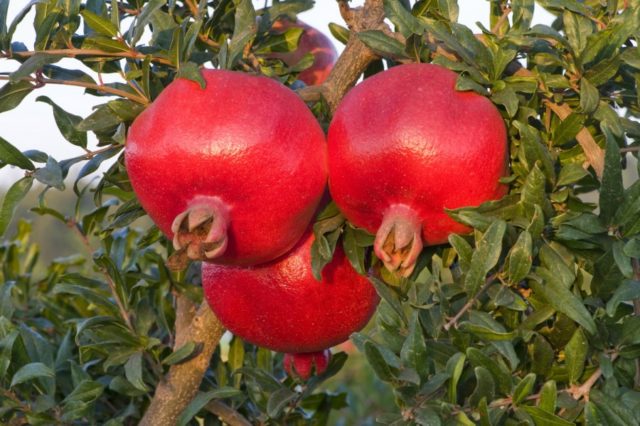

The size of the bush is 3 m in height. The mass of one fruit is 300-400 g. The grains are covered with a thin, pink film. The taste is sweet and sour. The variety is grown in Turkmenistan, Georgia. It ripens, as a rule, in October. The fruit can be stored for 3-4 months. Used to obtain pomegranate juice. Galyusha red grows and bears fruit in temperate climates, subject to shelter for the winter.
Galyusha pink
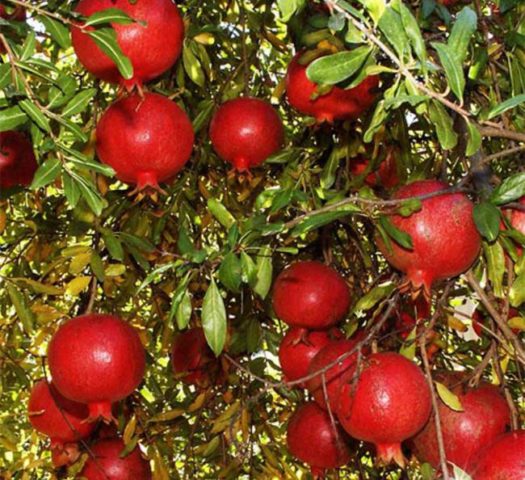

The pink pomegranate variety appeared in Azerbaijan. The average weight of the fruit is 200-250 g. It is distinguished by a more round shape. This variety of pomegranate is used to obtain juice. The yield of the liquid product is 54%. Suitable for making sauces. The grains are pink and medium in size. Galyusha is known for its interesting taste.
Nikitsky early
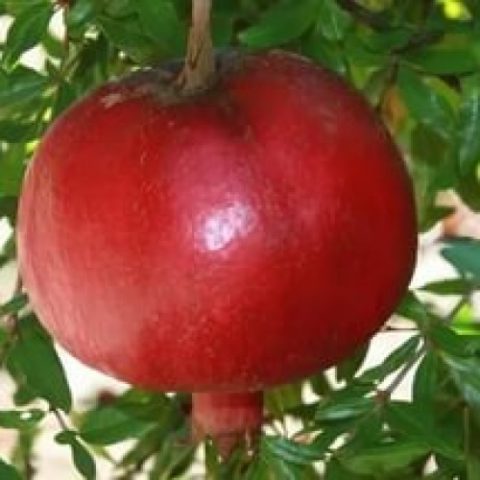

The pomegranate variety was bred in the Nikitsky Botanical Garden, hence the name. A high-yielding species that requires shelter for the winter. Nikitsky early is successfully grown in the central regions of Ukraine. The bush is medium-sized. Height 2 m. It blooms profusely throughout the summer. Inflorescences are male and female. The fruits are large. The early Nikitsky variety has an external resemblance to the Ordinary pomegranate.
Structure
Basic information about the composition of the pomegranate:
| Nutritional value per 100 g of edible portion | |
| Calories | 63-78 |
| Moisture | 72.6-86.4 g |
| Protein | 0.05-1.6 g |
| Fat | up to 0.9 g |
| Carbohydrates | 15.4-19.6 g |
| Cellulose | 3.4-5.0 g |
| Calcium | 3-12 mg |
| Phosphorus | 8-37 mg |
| Iron | 0.3-1.2 mg |
| Sodium | 3 mg |
| Potassium | 259 mg |
| Vitamin B1 (thiamin) | 0.003 mg |
| Vitamin B2 (riboflavin) | 0.012-0.03 mg |
| Vitamin B3 (niacin) | 0.180-0.3 mg |
| Vitamin C | 4-4.2 mg |
| Lemon acid | 0.46-3.6 mg |
The nutritional value
Pomegranate is a low-calorie fruit, which makes it an excellent weight loss product. Only 60-70 kcal per 100 grams! Of course, we do not advise you to go on a diet where this fruit is used as the "main ingredient". Because any diet (even those who are losing weight) must remain balanced and healthy.
The sweetest varieties of pomegranate
Taste characteristics are determined by the percentage of sugar and acid. Pomegranate varieties can be roughly divided into three groups: sweet, sweet and sour and sour. The minimum sugar content in sweet fruits is 13%, in sour fruits - 8%.
The taste characteristics of the pomegranate are influenced by the climatic characteristics of the growing area, variety, and the stage of fruit ripeness. Pomegranate loves a lot of light and warmth. Sweet varieties of pomegranate are exported from Tajikistan, Azerbaijan and Central Asian countries. An ideal region for growing fruit is the vicinity of the Talysh Mountains.
For the fruit to be sweet, it must be fully ripe. The main criteria for choosing a ripe fruit:
- peel from red to maroon;
- absence of spots, dents, external defects on the surface;
- a large fruit cannot weigh less than 130 g;
- dry and slightly stiff skin;
- no smell.
The following are the three sweetest varieties of pomegranate with a photo.
Dholka
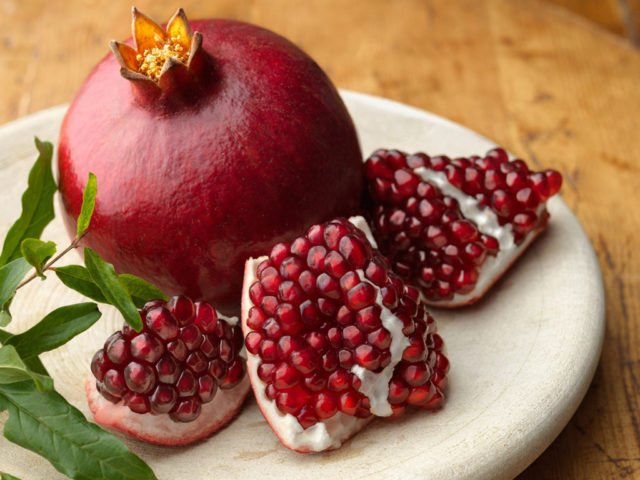

The natural growing environment is the territory of India. The fruits are light pink in color. The grains are the same shade or white. Fruit weight is 180-200 g. The culture belongs to medium-sized species. The height of the bush is 2 m. A very sweet fruit.
Important! In India, a drug that has an analgesic effect is prepared from the Dholka pomegranate root. The bark is used to prepare decoctions for worms and dysentery.
Ahmar


Pomegranate variety of Iranian origin. In terms of the amount of sugar it is difficult to find an equal The shrub grows up to 4 m high.Inflorescences are red-orange in color, medium in size. The buds appear in May and the flowering period lasts throughout the summer. The surface of the fruit is pink with a distinct green tinge. The grains are pink. They can be eaten.
Important! The lighter the appearance of the pomegranate, the sweeter the fruit tastes.
Nar-Shirin
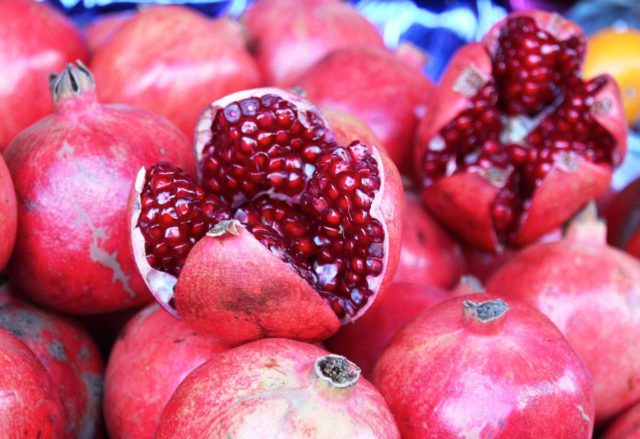

Another fruit is native to Iran. It resembles the previous variety in shape, color and taste. The rind is beige with light green blotches. The inner surface is pink. Almost all grains are even, perfect in shape. The hue ranges from light pink to crimson or red. Nar-Shirin is cultivated in the central part of the country. Gardeners cultivate Ahmar and Nar-Shirin varieties mainly for the domestic market.
Safety and contraindications
Despite all the positive qualities, in some cases, pomegranate can harm a person. There are important contraindications to its use:
- Exacerbations of chronic diseases of the digestive tract (peptic ulcer, gastritis, enteritis, etc.). The fruit increases the secretion of hydrochloric acid, and also causes irritation of the mucous membranes, which can aggravate the course of inflammatory pathologies.
- Constipation. Pomegranate is rich in tannins that slow down the motility of the digestive tract and increase the density of feces.
- Individual increased sensitivity (allergy).
In addition, it is recommended to drink a small amount of water (100-200 ml) or rinse your mouth after each pomegranate consumption. The systematic effect of the fruit on the components of the oral cavity can cause the destruction of tooth enamel and the development of caries.
Thus, one should competently relate to the use of pomegranate, carefully consider the range of contraindications and possible side reactions.
Use during pregnancy
The fruit is rich in folic acid, as well as other vitamins and minerals, which are extremely important for improving uteroplacental blood flow, maintaining a "healthy" tone of the uterus, and developing the fetal neural tube.
In the postpartum period, pomegranate helps to increase the production of colostrum and breast milk, which is especially important for people with hypogalactia.
The recommended maximum daily intake is from 200 to 400 grams per day.
Pomegranate can be consumed during pregnancy. It is useful for the full development of the fetus in the womb.
Reproduction
You can propagate momordica by seeds, seedlings or cuttings. Despite the strong shell, Momordica seeds do not require prior stratification. Seeds are sown at the very end of March or early April.
Usually they are pre-soaked for about 20 hours in a pink solution of potassium permanganate. Then they are sown in pots with a diameter of 10 cm, filled with a nutrient mixture consisting of 2 parts of leafy earth, 2 parts of humus and 1 part of sand. Then the pots must be put in a box, covered with foil and put in a warm place with a temperature of 22-25 ° C, preventing the earthen coma from drying out. At the same time, friendly seedlings will appear through
With the appearance of the first shoots, the film must be removed, the pots must be placed as close to the light as possible and the temperature must be reduced to + 15 ° C for days so that the plants do not stretch. It is useful to spray seedlings from a spray bottle in the evening.
On the following days, it is necessary to maintain a temperature of + 20-25 ° C. It is important to monitor the moisture content of the soil and air - it should be within the limits. Overdrying of the soil is unacceptable.
Before planting in a permanent place, Momordica seedlings must be gradually hardened, accustoming them to the conditions of open ground, where they are planted when the soil at a depth of 10 cm warms up to + 11-12 ° C. It is necessary to plant young plants in a permanent place with a clod of earth, trying not to damage the roots. This is best done during the daytime.
It is necessary to water the plant often and only with warm water, regularly spray the entire plant.
Since momordica grows very quickly, it must be fed every day with mullein solution.
Read also Sound and noise insulation in the apartment materials
Like all creepers, her, need to formas she gives many stepchildren. It is better to form plants in two shoots, after which the active growth of stepsons begins, which bear fruit well. To do this, pinch the lateral shoots over the female flower, leaving it on top. But the stepsons should not thicken the crown of the plant.
Stepsons can be rooted. Rooting takes place in water in 2 weeks at a water temperature of + 25 ° C. Then such a rooted stepson can be planted in the ground and shaded.
be careful when pruning plants and twisting shoots. The fact is that before the beginning of fruiting, its leaves can cause skin burns like nettles... But with the beginning of fruiting, the plant quickly loses this feature.
Momordica is resistant to pests and does not require any spraying, except for treatment at the beginning of flowering with the preparations "Bud" or "Ovary" to accelerate the setting of fruits.
Features of growing momordica
Momordica can be grown in a greenhouse, a greenhouse, on a balcony and in a room on a windowsill. Basically, the plant is propagated with seeds, but the method of propagation by cuttings is also used. Some of the Momordica varieties are grown as ornamental houseplants, while others are grown as vegetable garden crops or as ornamental plants along fences and arbors.
Sowing seeds
As already noted, Momordica seeds have a fairly dense shell. However, they have a very high germination rate. They do not need special preliminary preparation, except for soaking in a weak manganese solution a day before disembarkation. Do not wait for seeds to germinate in water, by analogy with cucumber seeds, otherwise they will rot.
It is recommended to plant seeds edge-on to a depth of 1.5 cm in peat pots up to 10 cm in diameter, filled with a fertile soil mixture. Immediately after planting, they must be watered with warm water, after which they must not be watered for 2-3 days.
Read also Beetroot salads and snacks
The best time to plant seeds is late March or early April. Seedlings appear in 10-15 days at an ambient temperature not lower than + 20 ° С. The soil with seedlings must be kept in a moderately moist and warm state and the plants must be protected from drafts and sudden changes in temperature. It is recommended to fertilize the soil twice a month, alternating between organic and mineral fertilizing.
Can be propagated by Momordica and cuttings. For this, the shoots are placed in water or in a sand-peat mixture and wait for their rooting. The ambient temperature should not be lower than + 25 ° С. Ready cuttings are planted in open ground and covered with a glass jar for several days.
Open ground transplant
When the plant reaches a height of 25 cm, it is transplanted into a larger pot. They are planted in open ground at the end of May, they do it together with a basal earthy clod. Exposure of roots has a bad effect on the development of the plant, since its root system is poorly developed. Therefore, it is periodically necessary to add soil as it is washed out during watering.
If the site is not very warm, then the initial planting should be done in a greenhouse or under a temporary film cover. Momordica thrives in those places where crops such as potatoes, legumes, and tomatoes grew before it.
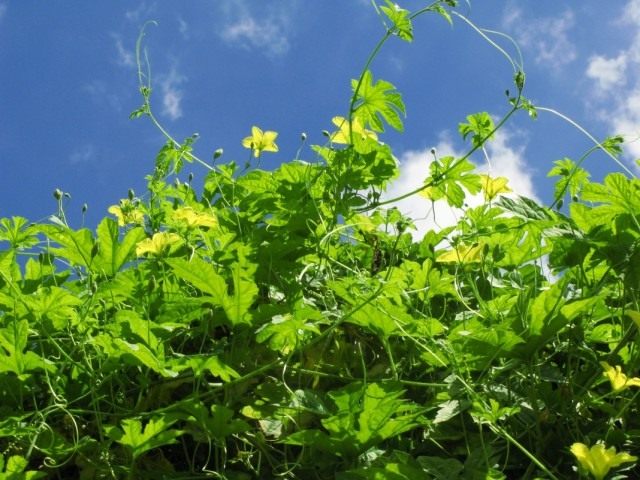

Momordica charantia.
Momordica's appearance
The Indian pomegranate looks more like an elongated pumpkin or an oblong cucumber. At first, the fruits are green, but as they ripen, they acquire a yellow, and then a rich orange color. They are all dotted with warts. A ripe plant tends to split at the bottom, exposing small growths in which the seeds are located.Momordica can also be recognized by its pleasant aroma during flowering. Its yellow flowers exude a scent similar to blooming jasmine.
Read also Corn porridge recipe
Meet Momordica
The fruit, which has so many different names, actually belongs to the Pumpkin family and is a distant relative of the squash we are used to. The fact that in ancient times in China only members of the imperial family could eat it can speak of its value. And in India it was considered a plant of the Gods. Ancient Asians (namely, Asia is considered the birthplace of this fruit) deservedly appreciated its beneficial properties. It does not interfere with getting to know them and us. So what is this fruit - momordica?
Momordica in cooking
When fully ripe, the momordica fruit cracks in the lower part and unfolds into three, less often four fleshy "petals". At the same time, the orange-red color of the inside of the fruit becomes visible, which tastes like persimmon. At this point, the seeds fall from the fruit to the ground. Thus, the already "cleaned" fruit is ready for use. It just needs to be removed on time.
Momordica fruits can be stored for days at a temperature of 11-12 ° C and high humidity - up to 90%.
In food, like cucumbers, unripe fruits are used, which contain a lot of protein. This is why they are more nutritious than cucumbers. The pulp of the fruit is slightly bitter, but very pleasant to the taste.
Before eating, it is advisable to soak the fruits in salted water. It contains a lot of vitamin C - up to 100 mg%. Salads, seasonings for meat dishes are prepared from the fruits, they are boiled and fried, pickled and salted.
The beneficial properties of momordica
It is known that in ancient China there is a momordiku that was allowed only to the emperor and his family members. In India, it was considered a plant of the gods, in Japan - the food of centenarians. In our country, this exotic cucumber can be tasted in Korean stores. Although our gardeners believe that growing momordica on their own is much more interesting and useful.
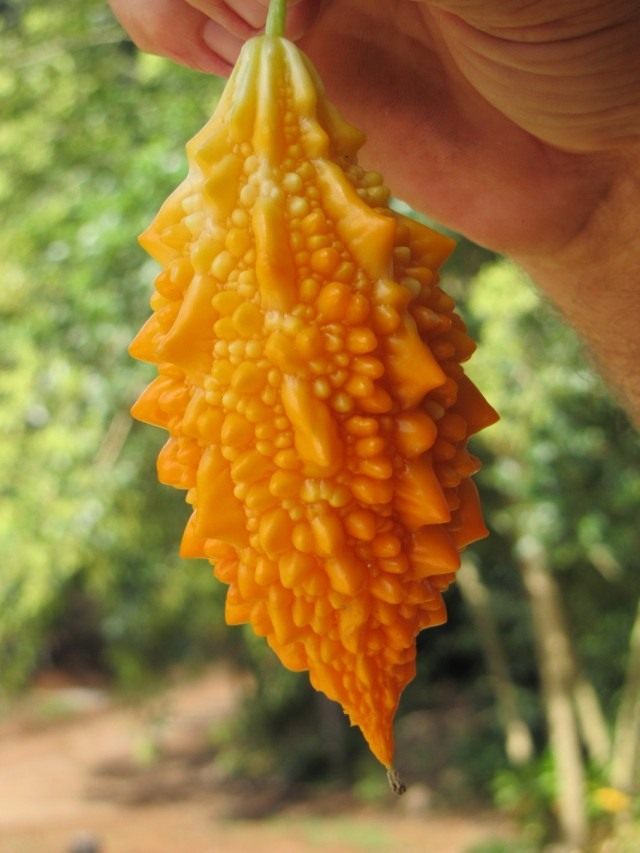

The ripe fruit of Momordica Charantia. <>
It is believed that all parts of the plant are nutritious and healing - roots, leaves, seeds, flowers and fruits. Fresh young shoots and leaves of momordica go to salads and vinaigrettes, from which delicious borscht and healing soups are cooked. "Warty cucumber" is much more nutritious than peppers and eggplants.
Vitamin E contained in the plant protects the human body from premature aging, vitamin F gives vigor and strength, folic acid nourishes the bone marrow, protects against tumors. Momordica destroys bacteria and viruses, treats hypertension, hemorrhoids, stomach ulcers, diabetes and even leukemia. Increases immunity, relieves pain. Quickly removes excess fat, accelerates metabolism, makes your figure slim. Reduces blood cholesterol levels, cleanses blood vessels.
It seems that the miracle cucumber is subject to all ailments, including rheumatoid arthritis, head and joint pains, burns, psoriasis, depression, furunculosis, hepatitis, prostatitis, urolithiasis, sclerosis. Momordica also treats eye diseases, improves visual acuity. It remains only to check!
Medicinal properties
And now about the medicinal properties of Momordica. In southern China, it is known as the "fruit of longevity." And this is no accident. The presence in it in a significant amount of three groups of compounds (insulin-like peptides, alkaloids and carotene) makes it possible to widely use Momordica in folk medicine to lower sugar levels in the blood of diabetics.
Momordica is widely used in traditional Chinese medicine for gastrointestinal infections. Recently, it began to be used in the treatment of tumors, lowering blood pressure.
Its seeds contain up to 55% fatty oil, their decoction is used to treat stomach and duodenal ulcers.
Momordica is also a good diuretic. And its leaves are applied to snakebite wounds.
Momordica is a herbaceous climbing vine from the pumpkin family.It has carved leaves, fragrant flowers and extraordinary fruits, ripe - similar to exotic bright orange flowers. She has many names: Indian, or yellow cucumber, crocodile cucumber, mad melon, Indian pomegranate, balsamic pear, etc. How to grow momordica in a greenhouse, on a balcony and in the open field, what kind of care it needs, and what properties are considered the most valuable, read the article.
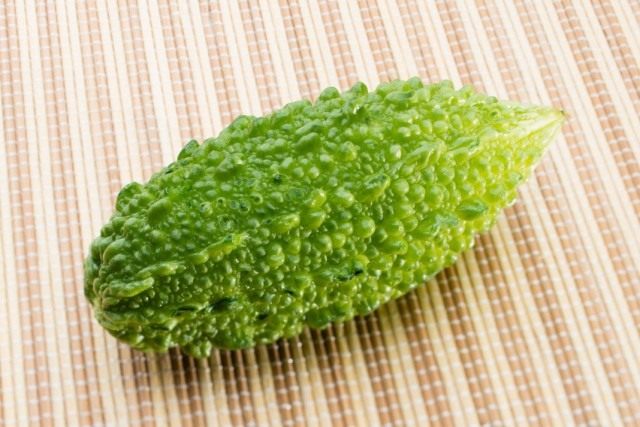

The fruit of Momordica charantia, or bitter cucumber (Momordica charantia).
Content:



